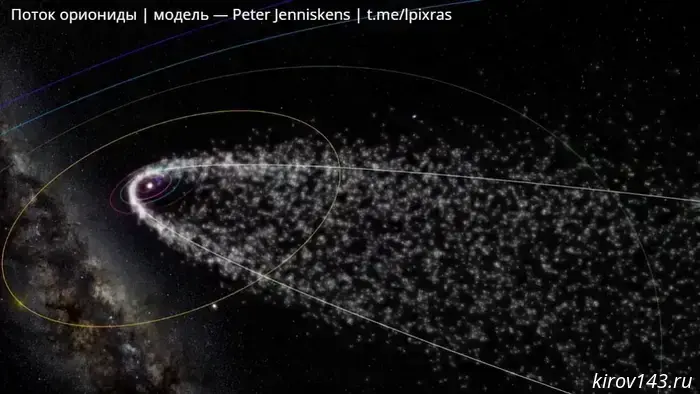
Night of falling stars: the Orionids meteor shower will be visible as early as tomorrow.
According to scientists, observing conditions this year are particularly favorable: it’s a new moon now, so the sky will be dark enough to see even faint meteors. The expected rate of the shower is 10 to 30 "shooting stars" per hour.
The radiant of the Orionids, that is the point from which the meteors appear to "shoot out," is located in the constellation Orion. It rises above the horizon at around 10–11 p.m. local time, and the best time to observe is from 1 to 3 a.m. Find the bright star Betelgeuse in the sky — the radiant is slightly north of it.
Scientists note that the Orionid stream consists of particles from Halley’s Comet scattered along its orbit. Although this shower is less spectacular than the famous Perseids and Geminids, it still remains one of the most beautiful autumn astronomical phenomena.
So, if you want to make a wish — now is the time. Take a warm blanket and go watch the stars tomorrow night.
Другие Новости Кирова (НЗК)
 Roskomnadzor confirmed the partial blocking of WhatsApp* and Telegram in Russia.
Roskomnadzor confirmed that it continues to partially restrict the operation of the messaging apps WhatsApp* and Telegram in Russia.
Roskomnadzor confirmed the partial blocking of WhatsApp* and Telegram in Russia.
Roskomnadzor confirmed that it continues to partially restrict the operation of the messaging apps WhatsApp* and Telegram in Russia.
 Two man-made fires were reported in Kirov Oblast over the past 24 hours.
From 6:00 on October 21 to 6:00 on October 22, firefighters in Kirov Oblast responded to two fires.
Two man-made fires were reported in Kirov Oblast over the past 24 hours.
From 6:00 on October 21 to 6:00 on October 22, firefighters in Kirov Oblast responded to two fires.
 Olympia congratulated its coach on their birthday.
Today Mikhail Zvyagin, head coach of Kirovo-Chepetsk's Olimpiya, turned 51.
Olympia congratulated its coach on their birthday.
Today Mikhail Zvyagin, head coach of Kirovo-Chepetsk's Olimpiya, turned 51.
 Schools in Dolgushino and the Zubarevsky Forest are in the red zone.
The Duma committee discussed the implementation of regional projects.
Schools in Dolgushino and the Zubarevsky Forest are in the red zone.
The Duma committee discussed the implementation of regional projects.
 Kirov owes the state and the banks 2.3 billion.
At a meeting of the Duma committee, the city's debt was discussed.
Kirov owes the state and the banks 2.3 billion.
At a meeting of the Duma committee, the city's debt was discussed.
Night of falling stars: the Orionids meteor shower will be visible as early as tomorrow.
Specialists at the Solar Astronomy Laboratory of the Space Research Institute of the Russian Academy of Sciences (IKI RAS) reported that in the coming days — October 23 and 24 — residents of Russia will be able to observe the Orionid meteor shower, which has reached near-peak activity.
